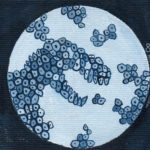Lien vers HAL – pasteur-05263949
Lien DOI – 10.1101/2025.07.12.664512
During Napoleon’s retreat from Russia in 18121, countless soldiers of the French army succumbed to infectious diseases, but the responsible pathogen or pathogens remain debated2–5. We recovered and sequenced ancient DNA from the teeth of 13 soldiers who, based on historical records, likely died from infectious diseases, aiming to identify the pathogens responsible for their deaths6. Our results confirmed the presence of Salmonella enterica subsp enterica belonging to the lineage Para C, the causative agent of paratyphoid fever7 ; and Borrelia recurrentis, responsible for relapsing fever transmitted by body lice8. We were not able to detect Rickettsia prowazekii (the agent of typhus) and Bartonella quintana (the cause of trench fever), which had previously been associated with this deadly event, based on PCR results and historical symptom descriptions3. The presence of these previously unsuspected pathogens in these soldiers reveals that they could have contributed to the devastation of Napoleon’s Grande Armée during its disastrous retreat in 1812.


